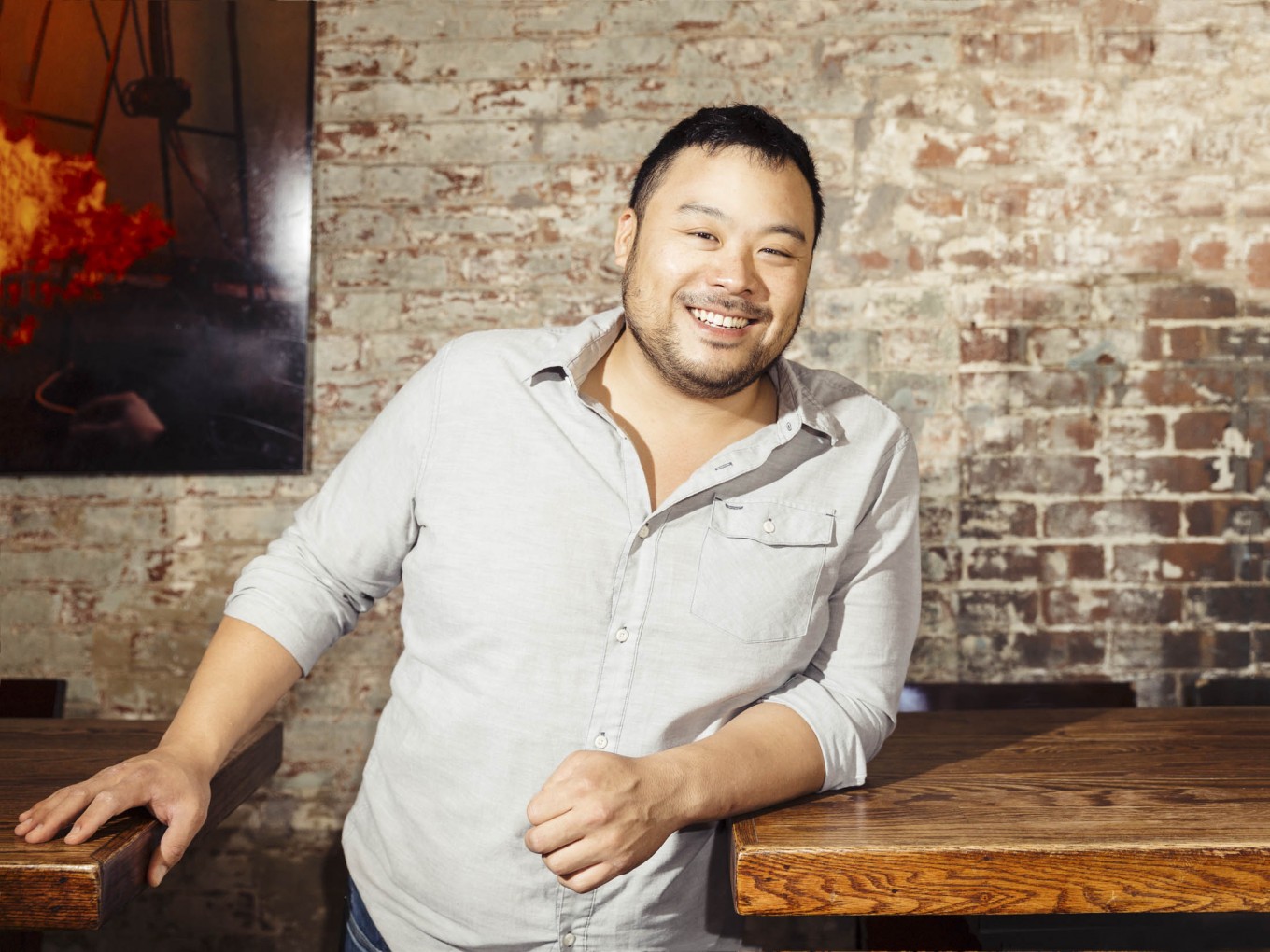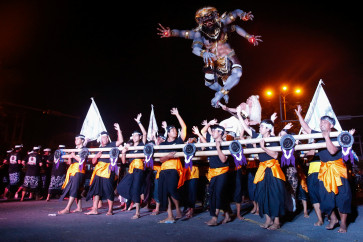The new Momofuku is in Columbus Circle. Don’t tell David Chang
Change text size
Gift Premium Articles
to Anyone
 Since he opened his first Momofuku Noodle Bar in a no-frills East Village storefront in 2004, David Chang has become renowned as a chef who shakes things up. (Bloomberg/-)
Since he opened his first Momofuku Noodle Bar in a no-frills East Village storefront in 2004, David Chang has become renowned as a chef who shakes things up. (Bloomberg/-)
S
ince he opened his first Momofuku Noodle Bar in a no-frills East Village storefront in 2004, David Chang has become renowned as a chef who shakes things up.
The third floor of the Shops at Columbus Circle, in midtown Manhattan, is not the place I would imagine Chang doing that. Yet Chang and his team are embracing the location of his second New York Noodle Bar, opening on Thursday, Nov. 15. But the notoriously stubborn chef won’t call it “the Shops at Columbus Circle,” the name owner Related Co. insists on. “I will always say ‘Time Warner Center,’” says Chang.
I spent a lot of time at the original Noodle Bar, most recently home to Momofuku’s fried chicken-sandwich takeout spot, Fuku. There were 22 seats, about six items on the menu, and OB beer, with $1 bottles of Poland Spring water. Since then, his empire has grown to include restaurants in New York, Sydney, Toronto, Los Angeles, Las Vegas, and Washington.
The new Momofuku has a designer—Inc. Architecture & Design—and 90-plus seats, most of them stylish booths, as well as a dedicated cocktail bar and a private dining room. At the helm is executive chef Tony Kim, who ran the Noodle Bar kitchen after it shifted a few doors to its present location.
“Yeah, we’re on the third floor of a shopping mall,” Chang tells me. “You don’t think there’s going to be a heartbeat, so we’re trying to create the sense of controlled chaos.” In a preview Chang gave me in early November, I was able to check out some of the highlights.
The specials board
To combat the mall setting, Chang created a feature that invigorates the location while combating the clamor for such signature dishes as pork-belly-stuffed buns and ramen. “How do you do nostalgia without being stuck in it? You have to have a new menu every day,” he answers.
The new location boasts a train station-style departure board over the bar that cycles through specials. “Whole Dover Sole @7.30,” and “Black Truffle Ramen” are some of the dishes that could pop up and then disappear when they sell out. Chang credits his constant travel. “I have been living in train stations and on airplanes. We created a Warby Parker board; it’s the same concept as a chalkboard, but it’s constantly updating.”
The ramen
Like a sequel in the Avengers series, Momofuku has taken its greatest hits and updated them. The biggest change for any fans (me) of their ramen template is that the noodles are now custom made, in partnership with Sun Noodles. The result is strands with a more pronounced grain flavor.
Most significant, they’re more durable and stay relatively firm in a bowl of broth for upward of 30 minutes, the equivalent of a ramen superpower. “Back in the day, I would say, eat your food and get out of here; the noodles don’t wait,” says Chang. “Chang won’t be cooking here,” says Kim.
Those noodles come into play in the spicy beef ramen with chunks of short rib and the garlic chicken ramen with the Asian leafy green, yu choy. The signature bowl is smoked pork ramen. The deep, brown broth is chicken-based, with a fresh, crunchy wedge of bamboo floating on top, bumping into the caramelized pork slice and slow-poached egg yolk. “When we started adding slow-poached eggs to ramen, no one was doing it. We couldn’t afford the labor to peel hard-boiled eggs,” says Chang.
He sees this as the culmination of the ramen he’s been making over the 14 years he’s been serving it: version 14.0. “There are stretches when our ramen has been bad; we changed the broth, we went to pork, we went away from pork. It’s like a sports team—you have some bad seasons.” The ramen price will be in the high teens.
The buns
Chang has seen his pork belly buns copied around the world, but he decided to embrace the steamed bun instead of running away from it. “If everyone is making one, we have to be the best-in-class,” he says.
The team is now making the buns in-house, too. The process is neither labor- nor space efficient, according to Kim: Every day, two to four cooks are dedicated to preparing them; it is also the base of the flatbread rotisserie meat sandwiches at the adjacent, just-opened Bang Bar.
The signature bun at midtown Noodle Bar is the French dip—fans of the pork belly version will have to wait for it to make an appearance on the specials board. “I’ve been eating a lot of French dips in L.A.,” explains Chang. Here, they are filled with chunks of braised short rib and onion with a bowl—shaped like a fancy shell—of black vinegar-spiked broth. “This bun is the hardest thing we’re doing in this restaurant. Tim Ho Wan [the Michelin-starred dim sum expert] doesn’t mess around with the shape of dough. But we’re embracing the artisanship,” says Kim.
I found them sweet and puffy, with a pillowy, chewy bite.
The drinks
The new Noodle Bar is a dedicated spot for drinks that, by itself, is about as big as the original Noodle Bar counter. Momofuku bar director Lucas Swallows worked with Anne Robinson (a Booker & Dax alum) to create what they call a “House Soda Fountain.” Their Highball Program includes the Sundial, made with tequila, suze, and clarified orange cordial and decorated with little orange cut outs. The Fun Guy features soju infused with dried shiitake and vermouth, with results unexpectedly like a cream soda.
Read also: NYC ‘cheap eats’ list makes it official: Dining bargains abound
The new signatures
Kim and his kitchen are pushing a handful of dishes that have made appearances at East Village Noodle Bar. Oxtail soup is served in a handsome Le Creuset pot, with rice cakes in a spicy broth. The meat is bone-in; Chang suggests customers pick it up with their hands. The same goes for the head-on Szechuan shrimp: a plate of plump shellfish coated in a piquant spice mix of coriander, cumin, and Szechuan peppercorn.
The team is considering serving then without silverware, so customers will be forced to eat with their hands. “There’s a lot of reasons for this dish. Head-on shrimp are the most delish, easiest way to eat them. People eat soft-shell crab; this is essentially that,” says Chang. I told him I would eat the whole thing but not the top of the head, with those giant eyes staring up at me. “You don’t have to eat them,” he said. He didn’t eat them, either.









